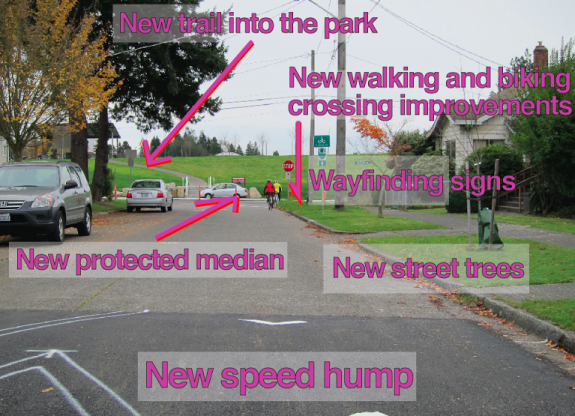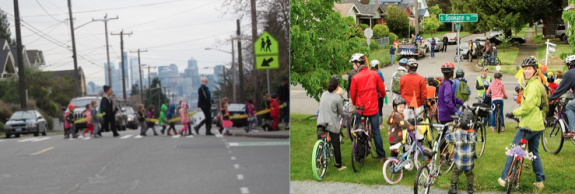This op-ed is by Gordon Padelford. He is the Neighborhood Support Coordinator with Seattle Neighborhood Greenways, lives on Capitol Hill, and loves parks.
Have you heard there is a new parks levy in the works?
Seattle Neighborhood Greenways has been participating in the parks levy discussion as a safer streets coalition because people throughout Seattle are separated from their favorite parks by dangerous roads, and we believe this can and must change!
Through a great deal of effort and luck, one of our coalition members, Beacon B.I.K.E.S., inspired a creative collaboration between Seattle Parks and SDOT staff so that the Beacon Hill Greenway now seamlessly connects across S Spokane St to Jefferson Park. A corresponding gateway and trail into Jefferson Park now welcomes community members. What was once an insurmountable barrier for kids and elders is now a wonderful access point.
 We can’t count on the bureaucratic stars aligning every time communities need better access to and through parks. We believe equitable access is a basic, core function of our park system. That is why we’re excited the new Parks funding proposal includes funding for safe access to into parks.
We can’t count on the bureaucratic stars aligning every time communities need better access to and through parks. We believe equitable access is a basic, core function of our park system. That is why we’re excited the new Parks funding proposal includes funding for safe access to into parks.
There are many other proposed investment initiatives on the levy that are outside the scope of our mission to comment on, and you should decide for yourself whether they are worthy to be funded. What is critical is that the $321,000 for connecting to our parks be maintained as the package moves forward, or even increased to be commensurate to the great need for more accessible parks.
Please sign our letter, or show up to the public hearing on Monday April 7th at 6pm at City Hall and voicing your support for safe and equitable access to parks.
Much attention has been given to equity in terms of geographic distribution of park resources, and rightly so. In addition, we need to start considering how physically accessible parks are to the people who live near them. Parks should be accessible to people of all ages and abilities, not just able-bodied adults who can dash across lanes of traffic.
 The Seattle Neighborhood Greenways community coalition envisions a Seattle parks system where our kids can safely bike to and through parks for fun, or simply to get home. We envision a Seattle parks system where grandparents can safely walk to and through our parks as they enjoy staying active or to pick up a quart of milk from the grocery store. More abstractly, as the 2011 Bands of Green Report calls for, we envision our parks seamlessly woven into the urban fabric of City, and connected to each other by green & pleasant trails and neighborhood greenways. Our vision is shared by many partners including Cascade Bicycle Club and Seattle Parks Foundation.
The Seattle Neighborhood Greenways community coalition envisions a Seattle parks system where our kids can safely bike to and through parks for fun, or simply to get home. We envision a Seattle parks system where grandparents can safely walk to and through our parks as they enjoy staying active or to pick up a quart of milk from the grocery store. More abstractly, as the 2011 Bands of Green Report calls for, we envision our parks seamlessly woven into the urban fabric of City, and connected to each other by green & pleasant trails and neighborhood greenways. Our vision is shared by many partners including Cascade Bicycle Club and Seattle Parks Foundation.
Investment initiative 4.9 called “Activating and Connecting to Greenways” is a good first step towards this vision. It provides $321,000 per year to allow the Parks Department to work across silos and collaborate with SDOT to make our parks more accessible to people walking and biking, and help connect parks with neighborhood greenways. There are roughly 200 places where proposed neighborhood greenways could better connect parks or trails. In addition, through this initiative the Parks Department could help provide valuable expertise when Seattle hosts open streets events (similar to Portland’s Sunday Parkways) that link parks.
Want even more background information before you sign sign our letter or show up to the public hearing?
The 2008 Parks and Greenspaces Levy, a property tax that funds $24 million per year of parks maintenance and operation expires at the end of 2014. If nothing is done to replace it the parks we all love will fall further into disrepair and an estimated $267 million maintenance backlog will grow even larger.
A citizen’s advisory committee, called the Seattle Parks and Recreation Parks Legacy Plan Citizen’s Advisory Committee — that’s a mouthful — was established by the City Council in 2013 to help advise our elected leaders on the content and structure of the next parks levy. In their final report, they recommended $57 million per year to maintain and invest in our parks. In terms of structure, the citizen’s advisory committee and the mayor proposed using a metropolitan parks district rather than a traditional levy to fund the package. Stay with me — it’s about to get wonky.
A metropolitan parks district is a special taxing district similar to a port or a school district that has the permanent ability to levy property taxes up to a level specified by the state. Being a separate entity, it is not constrained by the total bonding capacity of the City of Seattle. The way this parks district is proposed, our elected City Councilmembers would be the chairs of the district and would be able to direct funding to the existing City of Seattle Parks and Recreation Department. In plain English, the proposed Seattle Metropolitan Parks District would simply give the City Council the authority to levy a property tax that can only go towards funding our parks.
I’m not here to convince you of the efficacy of a parks district vs a traditional levy vs other sources of revenue, although Cathy Tuttle, myself, and the Seattle Neighborhood Greenways’ steering committee do think it’s a good way to fund our parks, assuming certain accountability and transparency measures are built into it. To learn more view the Mayor’s FAQ or the FAQ of the Seattle Parks for All campaign.
Finally, as Mayor Murray said, “ultimately my goal is not getting my funding source passed, it’s getting our parks funded.”
This parks district proposal funds $57 million per year in maintenance and investment initiatives. It was proposed by the citizen’s advisory committee, tweaked slightly by the mayor, and now is being reviewed by the City Council’s Select Committee on Parks Funding.
This committee is hosting a public hearing on Monday April 7th at 6pm at City Hall, and they want to hear from people like you about what is important. If connecting safely to parks is important to you, please consider showing up (even if you don’t want to speak we’ll have green scarves to wear in a show of support). If you can’t make it, please consider signing our letter. The future of our parks is in your hands.









Comments
6 responses to “Padelford: Let’s invest in neighborhood access to parks”
Thanks for the op-ed, Gordon!
The park closest to my house is separated from the neighborhood by a busy street, a concrete wall, and a steep flight of stairs. Seattle needs better connections between parks, neighborhoods, and greenways to make open space accessible to all its citizens.
Here on Lower Queen Anne we got funds to remake lower Kinnear Park with handicap access. In the plans was an access ramp into the park on Roy Street. SDOT did not like the ramp going into the park so they built a curb. Now park trucks have to drive up onto the curb to get into the park. The disabled have to access the park through a sidewalk ramp way down the street and also navigate the bicyclist on the sidewalk who want to go into the park. Long story short I heard SDOT in now conceded in putting in a ramp up into the park entrance and also placing a disabled parking spot at the entrance. This would not have happened unless the community checked on the work being done. If you see something out of place write to the department, the council and mayor. It takes us to make sure that things are getting done right in our neighborhoods. Accessible parks, walkable neighborhoods and safe bicycle streets as well as traffic calming circles and bumps. Let us all get out and enjoy the city we live in.
Great piece. We need a similar solution for crossing 35th Ave SW at Dawson to access Camp Long.
Sally Bagshaw has also put out a good FAQ about the proposed parks district for anyone who is interested: http://bagshaw.seattle.gov/2014/04/04/investing-in-our-future-the-proposed-seattle-park-district/
Speaking of access to and *through* parks, if anyone has concerns about the two-month, 24-hour a day, 450′ dismount detour at the sculpture park, here are some people to contact:
http://parkways.seattle.gov/2014/03/28/installation-of-monumental-art-piece-affects-olympic-sculpture-parks-bike-path/
In terms of distance, this is roughly like making the Fremont Bridge span (500′) a mandatory dismount for two months. Except the Fremont Bridge sidewalk is a *lot* narrower, so it would have more justification in that case. (Imagine the outcry from cyclists if that happened.) And for those who don’t think it’s a big deal to just ignore the numerous and unmistakeable dismount signs, consider that it puts bicyclists in a bad light in notoriously polite Seattle when they blatantly violate posted rules. I recently saw a female commuter (ahead of me) physically obstructed and berated by a pedestrian for riding her bike through.
The command to dismount at all times and circumstances puts an undue burden on bike commuters when there are frequently few-to-no pedestrians present. The rule is not reasonably related to the goal of facilitating user mobility and safety. It will cause a daily bike commuter to walk more than seven miles during the closure. Moreover, there are less restrictive means to promote safety and reduce conflict, such as a speed limit and/or “slow” signs. For example, how hard would it be make a sign that reads: “Cyclists Pass Pedestrians at 5 mph max.” The dismount requirement is an arbitrary and capricious mandate. I doubt SAM intended this, but it comes across as a gesture of disrespect to people who use a bicycle as a form of transportation.
SAM is an organization that depends on the goodwill of the public for its survival. It is surprising to me that it is apparently willing to alienate cyclists in this manner.